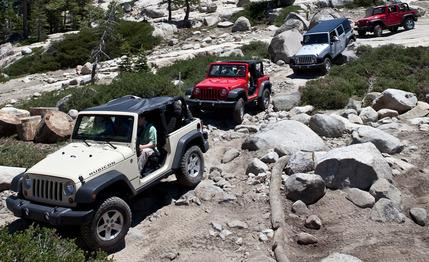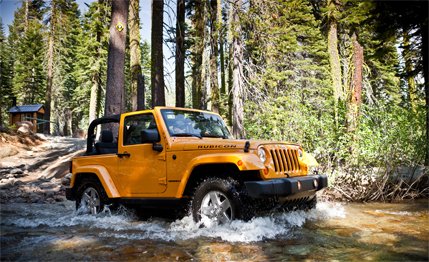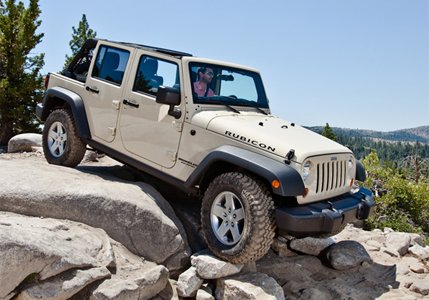 First Drive Review
First Drive Review
It’s hard to imagine a scenario in which having six dash lights ablaze in our instrument cluster wouldn’t induce sheer panic. But out here on California’s gnarly, rocky Rubicon Trail, the glowing icons—for low tire pressure, ESC off, anti-roll bar disconnected, front-differential locker engaged, rear locker engaged, and four-wheel-drive active—are a welcome sight. Less welcome is the shriek from underneath the 2012 Jeep Wrangler as skid-plate metal attempts to grind itself back into the earth, whence it came. And we’re just at the beginning of the trail.
Strapped into a new Rubicon-edition Wrangler (no coincidence, that), we chuckle, sometimes fret, as the Jeep’s 32-inch knobbies scavenge for grip in bedrock and up crag faces that turn our view into a disorienting sea of blue and white. The trail is as eager as ever to fold tailpipes and bumpers, and its cambered rock valleys are tight enough to put a hold on normal respiration. The Rubicon Trail is a mean maid. But, fittingly, even a bone-stock Wrangler Rubicon can tame it. So, point taken: Nothing Jeep has done to the 2012 model has made a sissy of the Wrangler.
This ’12 Wrangler is actually the culmination of a two-part refresh that began with the 2011 model. Last year, the cabin was rid of plastics as unyielding as the boulders we’re crawling over. It might not have reached a Bentley level of poshness, but the interior now favors dash wipes over garden hoses. Along with new heated mirrors and seats and added sound deadening, the Wrangler’s polish continues outside when optioned with the body-colored hardtop. In sum, it is a convincing enticement to customers holding reservations about living day to day with a Wrangler. But even as the ’11 Jeep gained amenities, it remained handicapped by its dismal powertrain, which included a four-speed slushbox and a wheezy 202-hp, 3.8-liter V-6. The 2012 Wrangler rectifies this via Chrysler’s new but already ubiquitous Pentastar V-6.

Having made its debut in the Wrangler’s affluent cousin, the Grand Cherokee, the 3.6-liter that’s now the sole engine option for Wrangler and Wrangler Unlimited models gets a faintly different tune here, producing 285 horsepower at 6400 rpm and 260 pound-feet of torque at 4800 rpm. That’s a loss of five horsepower to the GC in favor of more midrange torque. Alterations for the Wrangler application include a different intake system contributing to that torque, a revised oil pan to prevent starvation at steep angles, and the relocation of the alternator to the top of the block in the interest of water fording. The engine can be paired with an optional five-speed automatic transmission, identical to the GC’s unit, but comes standard with Chrysler’s first offering of a Pentastar/six-speed-manual combo. The manual box is a carry-over—albeit with a new clutch, clutch damper, and flywheel—and maintains its excellent crawl ratio.
On the paved paths we commuters call “roads,” the new powertrain helps loft the Wrangler up and into the realm of legitimate on-road vehicles. Relax, die-hards; even with retuned shocks, the Wrangler retains its classic lane-wavering nature. But now, passing on a two-lane road doesn’t recall a game of chess with Bobby Fischer. Red-light getaways are by no means brisk, but you needn’t eat Prius dust any longer.
Stops at the pump ought to be less frequent as fuel economy should improve by
1 or 2 mpg in both city and highway mileage (for both manual- and automatic-transmission applications). Prices range from $22,845 for a Wrangler Sport to $34,370 for a Wrangler Unlimited Rubicon. Depending on model, that’s between zero and $300 more than the 2011 version.
The Wrangler and its predecessors have always charmed owners with their crude compromises, which, ironically, only enhanced their appeal. But now, with a livable interior and—finally—a decent powertrain, the Wrangler can better serve as a daily driver, should you be so inclined.
